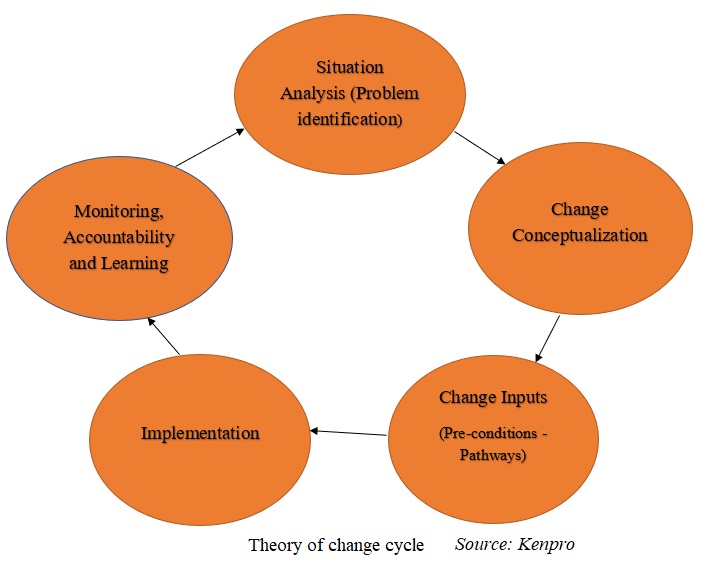Authors: Anthony M. Wanjohi1 and Hosea C. Gicheru2
1,2 Kenya Projects Organization
P.O. Box 15509-00503, Mbagathi, Nairobi-Kenya
Corresponding Author Email: wanjohi@kenpro.org
Theory of change is a very useful concept in development projects. Its application have seen success in many of the implemented projects. It is for this reason that donors have incorporated the theory as part of the requirements for funding. This article provides an overview of the application of the Theory of Change in proposal writing within the broader context of development projects.
Introduction
The theory of change can be defined as a planning, participation, adaptive management, and assessment technique that is employed by businesses, charities, non-profit organizations, international development agencies, academic institutions, and governmental agencies to encourage social change (Brest, 2010). Theory of Change outlines long-term objectives before mapping backwards to determine necessary prerequisites.
The theory has three key features that contribute to its success. The first feature is that the theory is context-specific focusing on defining a specific intervention (intervention-oriented). The second is that the theory bases its context on the future projecting the intended tangible results after the completion of a project (result-oriented). The third feature is the constantly evolving nature of the theory in reflection of the nature of the environment of the project (ever-evolving) (Janzen, Ochocka, & Stobbe, 2016).
In the context of development, the main aim of undertaking a certain project is to improve or alleviate the standing of the community that is set to benefit from the set project, hence a positive change. The theory of change in this case sets out to explain how and why the proposed project or program will be best suited for a certain community.
The theory pushes for a proper conceptualization of the proposed project from the problem it seeks to address to the expected outcomes resulting from the project. Identifying these factors is critical in attracting potential donors and securing funding from organizations that may share similar goals. Many donors often require a written proposal clearly indicating the application of the theory.
Theory of Change in Funding Proposal Writing
The theory of change has been applied in proposal writing. The theory is used in the preparation of a proposal to highlight the current issues in the community that the project aims to solve as well as the expected impacts of the project.
The theory application in proposal writing can be described in a theory of change cycle. Figure 1 shows the theory of change cycle in proposal writing.
Situation Analysis: Situation analysis is defined as the current situation of a given community before the implementation of the proposed project. It is important for the donor to understand the prevailing situation prior to investing in a project. Problem identification is the main issue that this part of the cycle presents.
Change conceptualization: In this part of the cycle, the task at hand is the identification of a suitable solution that is aimed at solving the problem identified in the first stage of the cycle. When writing a proposal, a well-thought-out action plan is required where the project’s desired long-term change takes centre stage. The theory of change aids in determining the whole spectrum of adjustments required to produce the desired impact. Graphical representations like flow charts, maps, network diagrams, or tables are increasingly frequently used to visualize the concept.
Change Input: Change input takes into account two components, namely pre-conditions and pathways. Pre-conditions refer to the requirements necessary for change to occur. These include human, financial and physical resources. Pathway refers to the outcomes resulting from fulfilling the pre-conditions.
Implementation: In this section of the proposal, a description of how the project is planned to be implemented is written. The section is best shown using a logical framework and a project implementation plan. The logical framework shows the actions that produce outputs, outcomes, and the goal while the implementation plan indicates the activity, who is responsible and the timeline of a project (Wanjohi, 2022).
Monitoring, Accountability and Learning: Monitoring, accountability and learning is the last step where all assumptions have not been factored in the drafting of the proposal. It also considers the possible unforeseeable risk factors that may affect the project during its lifetime.
Conclusion
Proposal writing is one of the most important ways that development agenda are pushed. Through the theory of change, the conceptualization and implementation of these projects have been made possible by creating a well-defined and logical guide. Owing to the fact that the majority of communities in modern society have been able to come up with ideas that have blossomed into huge undertakings improving the social standings and the community as a whole is no mean feat. Therefore, it is important for all that have an interest in building sustainable communities to consider applying the tenets of the theory of change in identifying societal gaps, conceptualizing and implementing development projects.
References
Brest, P. (2010). The power of theories of change. Stanford, CA: Leland Stanford Jr. University
Janzen, R., Ochocka, J., & Stobbe, A. (2016). Towards a theory of change for community-based research projects. Engaged Scholar Journal: Community-Engaged Research, Teaching, and Learning, 2(2), 44-64.
Wanjohi, A. M. (2022). The Projects Guide: Basics of Planning and Management of Development Projects. Nairobi: KENPRO Publications.
Suggested Citation
Wanjohi, A.M. & Gicheru, H.C. (2022). Application of theory of change in development projects. http://www.kenpro.org/application-of-theory-of-change-in-development-projects/

